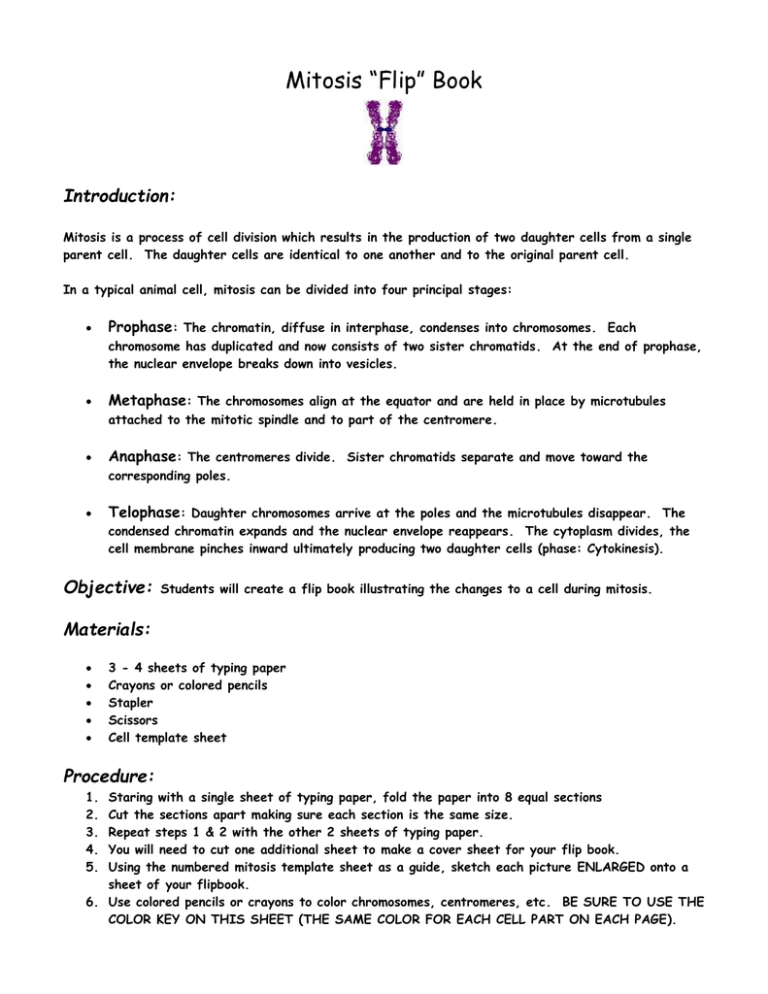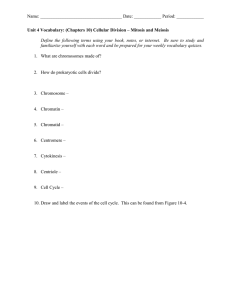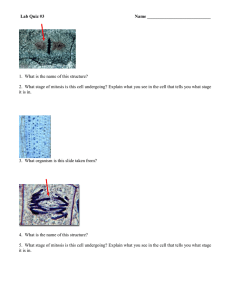Mitosis “Flip” Book Introduction:
advertisement

Mitosis “Flip” Book Introduction: Mitosis is a process of cell division which results in the production of two daughter cells from a single parent cell. The daughter cells are identical to one another and to the original parent cell. In a typical animal cell, mitosis can be divided into four principal stages: Prophase: The chromatin, diffuse in interphase, condenses into chromosomes. Each chromosome has duplicated and now consists of two sister chromatids. At the end of prophase, the nuclear envelope breaks down into vesicles. Metaphase: The chromosomes align at the equator and are held in place by microtubules attached to the mitotic spindle and to part of the centromere. Anaphase: The centromeres divide. Sister chromatids separate and move toward the corresponding poles. Telophase: Daughter chromosomes arrive at the poles and the microtubules disappear. The condensed chromatin expands and the nuclear envelope reappears. The cytoplasm divides, the cell membrane pinches inward ultimately producing two daughter cells (phase: Cytokinesis). Objective: Students will create a flip book illustrating the changes to a cell during mitosis. Materials: 3 - 4 sheets of typing paper Crayons or colored pencils Stapler Scissors Cell template sheet Procedure: 1. 2. 3. 4. 5. Staring with a single sheet of typing paper, fold the paper into 8 equal sections Cut the sections apart making sure each section is the same size. Repeat steps 1 & 2 with the other 2 sheets of typing paper. You will need to cut one additional sheet to make a cover sheet for your flip book. Using the numbered mitosis template sheet as a guide, sketch each picture ENLARGED onto a sheet of your flipbook. 6. Use colored pencils or crayons to color chromosomes, centromeres, etc. BE SURE TO USE THE COLOR KEY ON THIS SHEET (THE SAME COLOR FOR EACH CELL PART ON EACH PAGE). 7. Write a small number 1-36 in the lower right corner of each sheet in order to put them in the correct order in your flip book. 8. Once all the pages have been drawn, place them in the correct order with your cover sheet on top. 9. Place a cover sheet on top with ---- Mitosis Flip Book by “your name & period”. 10. Staple your booklet down the left side so you can “flip” pages and see mitosis animated. Results: Fill in the following table by entering the frame number range that corresponds to each of the phases of mitosis. Include a list of structures that can be seen in cells at each phase. If a structure can only be observed in a plant or animal cell, indicate so. STAGES FRAME NUMBERS (RANGE) STRUCTURES THAT CAN BE SEEN IN CELLS INTERPHASE PROPHASE METAPHASE ANAPHASE TELOPHASE Cell Membrane – BLACK Nucleolus – PINK Aster – BROWN Nuclear membrane – PURPLE Cytoplasm – YELLOW Chromatin – GREY Chromosomes – RED Centrioles – GREEN Spindle fibers – ORANGE Cell plate - BLUE The following diagram shows the cell cycle. Draw arrows from each mitotic stage to the correct cell sketch. Note: Interphase has been done for you. Also label G1 and G2 on the cell cycle. Identify each of these cell structures and their function. 1. Centrosomes – 2. Aster – 3. Equator – 4. Cleavage Furrow5. Cell Plate – 6. Kinetochore fibers – 7. Spindle8. Microtubules – 9. Cytokinesis – CHROMOSOME TEMPLATE SHEET



